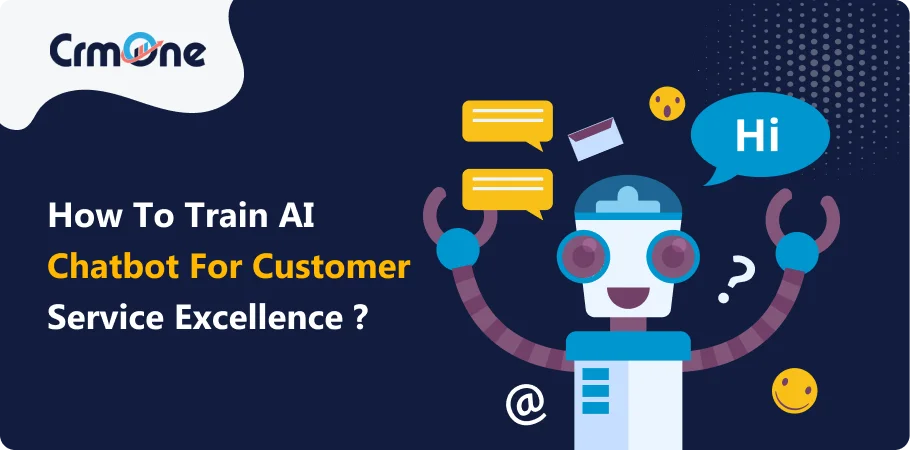In today’s digital landscape, businesses are harnessing the power of AI chatbots to revolutionize customer interactions and streamline operations. Through meticulous training, these training AI chatbot possess natural language processing (NLP) capabilities, enabling comprehension and response to user queries in real-time. Leveraging NLP, AI chatbot decode the nuances of human language, ensuring accurate comprehension of user’s question.
This not only enhances users experiences but also facilitates swift resolutions to customer concerns, ultimately improving operational efficiency. By integrating NLP into AI chatbot, businesses can personalize interactions and cater to individual needs effectively.
Consequently, AI chatbot serve as invaluable assets in modern people communicate engagement strategies, reshaping the dynamics of business-consumer relationships in the ai chatbot.
Understanding the Importance of Training ai chatbots
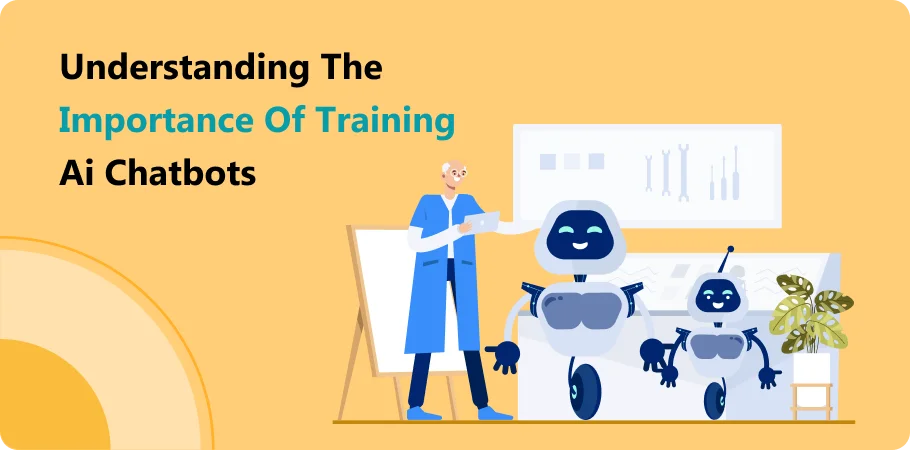
In the domain of ai chatbot, the tutoring of AI chatbot emerges as a critical endeavor, pivotal for ensuring these conversational agents can accurately comprehend user queries, discern their intent, and continually enhance their performance. Central to the essence of ai chatbot is equipping these training chatbots with the capability to grasp the nuances of the user’s intent and context, a feat accomplished through meticulous tutoring.
Without proper train chatbot might falter in deciphering the intricacies of customer queries, thus impeding their ability to generate meaningful responses. Moreover, in the dynamic landscape of evolving customer preferences, ongoing tutoring is imperative to facilitate adaptation and improvement over time. By refining their understanding of the user’s intent through ai bot & techniques, chatbot can tailor responses more effectively, thereby heightening customer satisfaction and engagement.
Fundamentals of AI Chatbot Training
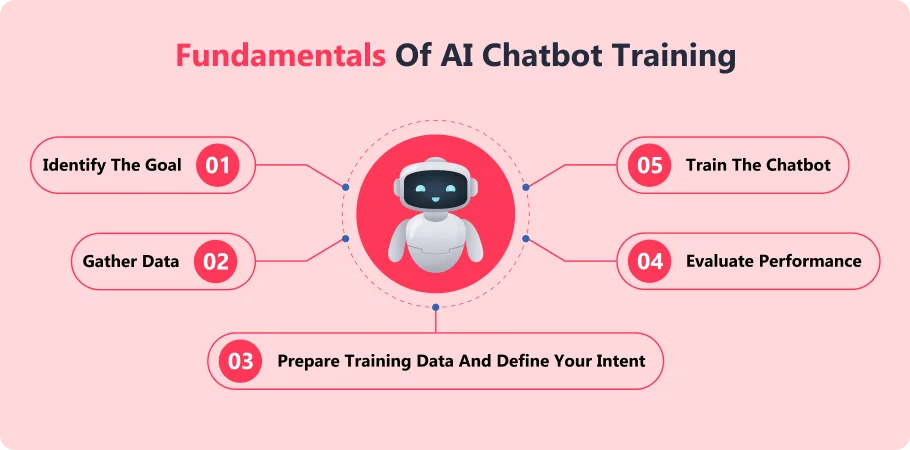
Before delving into the intricacies of tutoring ai bots, it’s crucial to grasp concepts such as nlp technology, machine learning algo’s, and expert systems. NLP techniques enable chatbot to parse and understand human language, empowering them to provide relevant responses to customer queries. Meanwhile, machine learning algo’s and expert systems facilitate chatbot in learning from data and making predictions, thereby enhancing their responsiveness.
To illustrate the significance of these chatbot, consider a previous example where a chatbot utilized NLP to comprehend a user’s inquiry and machine learning algo’s to generate a tailored response, showcasing the synergy between these technologies.
Neural networks, particularly deep learning models, play a pivotal role in processing complex linguistic patterns and generating coherent responses. Ultimately, a thorough understanding of these foundational concepts is essential for effective AI chatbot training and bot optimization.
Data Collection and Preprocessing
The initial step in train chatbot involves gathering and preprocessing data, which entails sourcing relevant datasets, cleaning and formatting the data, and identifying key features. Data serves as the foundation for training ai bots, providing them with the necessary input-output examples to learn from. However, data quality and diversity are critical factors that can significantly impact the performance of chatbot models.
To ensure continuous improvement, it’s essential to incorporate a variety of media component within the dataset, facilitating comprehensive learning experiences for the chatbot. Additionally, continuous improvement relies on iterative refinement, encompassing bot data quality and model performance.
By prioritizing bot diverse media elements and refining data quality, ai chatbot can undergo iterative cycles of improvement, enhancing their ability to effectively address customer needs.
Choosing the Right Tools and Frameworks
Selecting the appropriate tools and frameworks, such as TensorFlow, PyTorch, or spaCy, is essential for effective train chatbot. These tools offer a wide range of functionalities, including neural network implementation, data manipulation, and model evaluation.
When dealing with difficult conversations, these resources prove invaluable, enabling chatbot to navigate intricate dialogues effectively. Furthermore, leveraging these frameworks is integral to crafting chatbot capable of delivering human responses, thereby enhancing customers engagement and satisfaction.
Hence, the careful selection of tools and frameworks lays the foundation for AI chatbot adept at handling difficult conversations and eliciting human responses bot , thereby enhancing overall customers experiences.
Building a Training Pipeline
Creating a sturdy training pipeline involves outlining the architecture of the chatbot model, dividing the data into training and validation sets, and executing iterative training procedures. This pipeline acts as a structured framework, orchestrating the different phases of the training journey, from data preprocessing to model assessment.
By establishing a robust training pipeline, businesses can ensure the efficiency and effectiveness of their AI chatbot create efforts, ultimately enabling them to cater to the evolving needs of their customers in a rapidly changing digital landscape.
In today’s dynamic market, where staying relevant is paramount to meeting the evolving demands of customers, businesses must employ advanced technologies like AI bot. These conversational agents, trained chatbot through meticulous processes like defining model architecture and iterative training, enable businesses to enhance customer interactions and streamline operations.
Example; You choose a suitable machine learning model for image classification, such as a convolutional neural network (CNN), which is commonly used for tasks involving image data.
Categories to Train AI chatbots
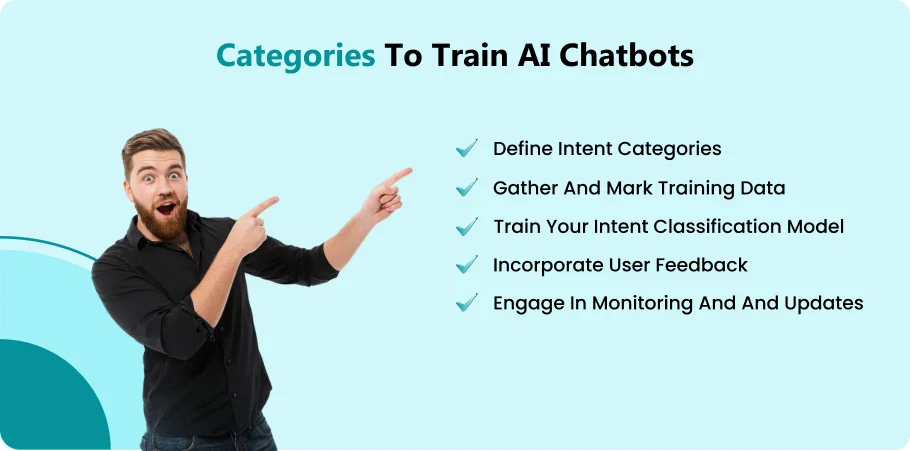
Supervised Learning Approaches
In the realm of AI bots, supervised learning methodologies play a pivotal role by leveraging labeled datasets to instruct the model on accurately mapping input-output pairs. Through this process, the chatbot undergoes training to grasp patterns within the provided examples, enabling it to generalize effectively and make precise predictions when faced with new data.
Essential tasks within supervised learning for chatbot encompass intent classification, where the model discerns the purpose behind customer inputs, as well as entity identification, which involves identifying specific elements within consumer queries.
Moreover, supervised learning facilitates the development of response generation mechanisms, enabling chatbot to craft human responses, thereby enhancing the overall layman’s experience.
Throughout the training phase, the chatbot’s comprehension extends beyond mere recognition, as it assimilates knowledge to generate responses akin to those crafted by humans. By honing its ability to generate human responses, the chatbot endeavors to foster engaging and create meaningful interactions with consumers.
This process is integral in ensuring that the chatbot not only accurately interprets consumer inputs but also delivers contextually relevant and coherent responses. Ultimately, through supervised learning techniques, chatbot evolve into adept conversational agents capable of seamlessly navigating diverse scenarios, enriching the customer experience with each interaction.
Unsupervised Learning Techniques
Unsupervised learning methodologies empower bots to uncover patterns within unlabeled data, cultivating adaptability across diverse conversational contexts. Unlike supervised learning paradigms, unsupervised learning dispenses with the necessity for labeled.
Within the training data framework, clustering algorithms such as K-means or hierarchical clustering emerge as instrumental tools, facilitating the grouping of analogous utterances or thematic elements.
These unsupervised learning techniques not only fulfill the imperative of adaptability but also address specific business needs by efficiently organizing and interpreting vast troves of unannotated data. Through this approach, AI bot acquire the agility required to handle complex conversations adeptly, navigating nuanced topics and create dialogues with finesse.
By discerning latent patterns and relationships within the data, unsupervised learning equips chatbot to respond dynamically to user inquiries and deliver tailored solutions, thus aligning with the multifaceted demands of modern business landscapes.
Reinforcement Learning Strategies
Reinforcement learning enables ai chatbot to evolve through iterative interaction with their environment, where they receive rewards or penalties contingent upon their responses. Within the realm of chatbot, this process proves invaluable for refining conversational fluency and enhancing user engagement.
In the chatbot training domain, reinforcement learning serves as a pivotal mechanism to train chatbot and fine-tune conversational agents. Through this iterative process, chatbot continuously process consumer inputs, refining their responses based on the feedback received.
By leveraging reinforcement learning techniques, developers can effectively train chatbot to navigate various conversational scenarios and optimize their performance over time. This iterative training process allows chatbot to adapt and improve their conversational abilities, leading to more engaging interactions with consumer.
Through reinforcement learning, chatbot undergo a continual learning process, honing their skills to deliver more natural and satisfying conversational experiences. By optimizing long-term rewards, chatbot can learn to generate more contextually relevant and consumer-friendly responses over time.
Fine-tuning and Transfer Learning
Utilizing transfer learning techniques and fine-tuning pre train models can expedite train talkbot while enhancing performance. Transfer learning involves transferring knowledge base from a pre-trained model, typically train on a large dataset, to a task-specific domain with limited data availability. This approach enables training chatbots to leverage existing knowledge and adapt it to cater to specific tasks or domains, such as handling inquiries related to a feature.
By harnessing transfer learning, developers can effectively optimize chat bot performance even when faced with constraints such as a specific dataset. Through the transfer of knowledge base from a pre-train model, talkbot can swiftly learn domain-specific nuances and cater to consumer wish list, including managing their wish lists.
Evaluating Chatbot Performance
Evaluating AI chatbot performance entails employing metrics like accuracy, precision, and recall, along with conducting human assessments. While quantitative metrics offer objective assessments of model performance, human evaluations are indispensable for gauging user satisfaction and engagement. Incorporating bot quantitative and qualitative approaches is essential to create a comprehensive understanding of the chatbot’s effectiveness.
By combining quantitative metrics with human evaluations, developers can create a holistic view of the talkbot performance. These assessments enable developers to identify areas for improvement and refine the chatbot’s functionality to better meet u needs.
Moreover, leveraging bot quantitative and qualitative evaluation methods empowers developers to iteratively enhance the talkbot capabilities, ensuring it delivers optimal performance and fosters meaningful interactions.
Book a CrmOne Demo
Experience the CrmOne simplicity and power. Our experts will show you the best ways to use it and answer your questions in real time. See how CRMOne fits your needs.
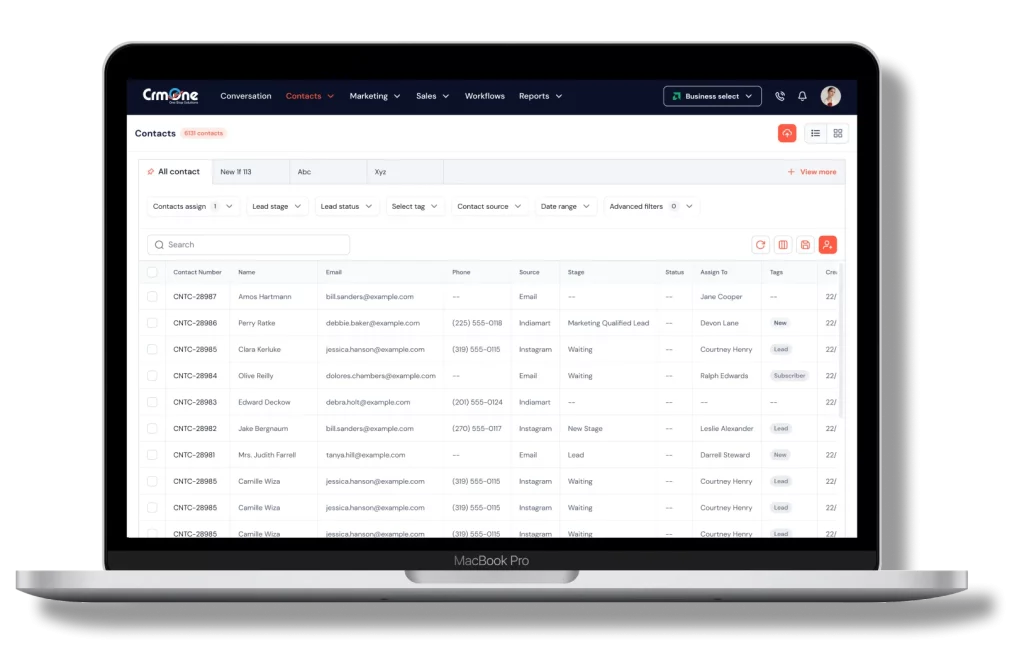
Challenges in artificial intelligence Chatbot Training
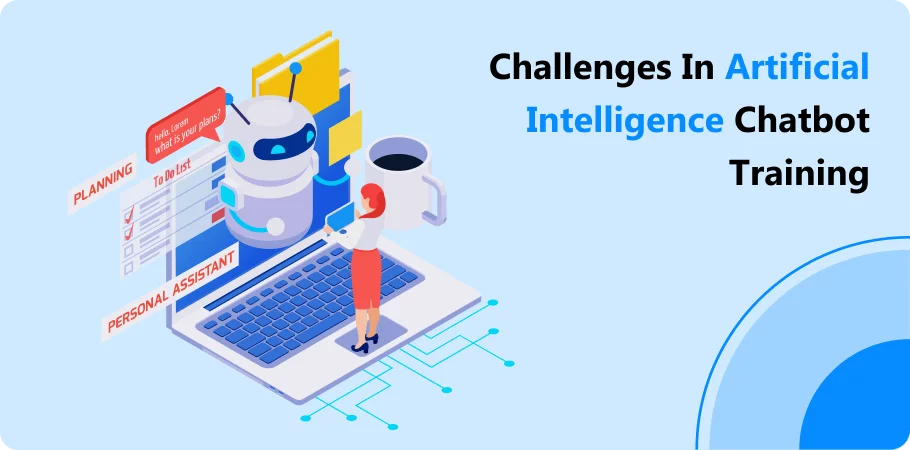
Train a chatbot comes with its set of challenges, including data scarcity, domain-specific nuances, bias, and ethical considerations. Data scarcity is particularly prevalent in specialized domains or languages where annotated data is limited, making it difficult to train accurate models.
In such cases, train chatbots may struggle to stay relevant and effective in providing meaningful responses, underscoring the need for innovative approaches to overcome data scarcity hurdles.
Furthermore, domain-specific nuances, like slang or colloquial expressions, can present obstacles for train talkbot, especially when operating in niche domains such as order status to create inquiries. These nuances may impede the talkbot ability to comprehend and respond appropriately to consumer queries about order status, affecting the overall consumer experience.
Additionally, bias within train data can lead to unfair or discriminatory outcomes, which is particularly concerning in contexts such as order status inquiries, where impartiality is crucial. Mitigating bias through careful data curation and algorithmic fairness techniques is essential to ensure that talkbot deliver equitable responses and maintain trustworthiness in handling sensitive information.
Enhancing Conversational Capabilities
Various techniques, including sentiment analysis, entity identification, and dialogue management, hold the potential to bolster train AI bot conversational prowess significantly. Sentiment analysis furnishes talkbot with the capacity to discern the inherent sentiment or emotional tone conveyed within consumers messages, thereby enabling the delivery of responses that are more empathetic and tailored to individual consumers.
This capability not only enhances consumers satisfaction but also ensures that interactions resonate on a deeper level, aligning with the train talkbot defined goal of fostering meaningful engagement.
Similarly, entity recognition plays a pivotal role in augmenting talkbot contextual understanding by identifying specific entities mentioned in consumers queries, such as names, dates, or locations. By incorporating this contextual information into responses, chatbots can deliver more nuanced and context-aware interactions, thereby enriching the overall conversational experience.
Leveraging techniques such as sentiment analysis and entity identification underscores the talkbot defined purpose of engaging consumers in meaningful conversations while leveraging the capabilities inherent in the ChatGPT model to craft responses that resonate authentically with consumers’ needs and preferences.
Dialogue management frameworks, such as Rasa or Microsoft Bot Framework, provide tools for designing conversational flows and managing dialogue state, enabling more natural and engaging interactions with consumers.
Addressing Bias and Fairness
Ensuring fairness in AI chatbot training necessitates proactive steps like gathering diverse datasets and employing bias detection algorithms to mitigate bias. This involves collecting data from varied sources and ensuring representation across demographic groups to reduce bias.
Bias detection algorithms can help identify and quantify biases present in train data, allowing for corrective actions such as data augmentation or algorithmic adjustments.
Methods to Train ai chatbots
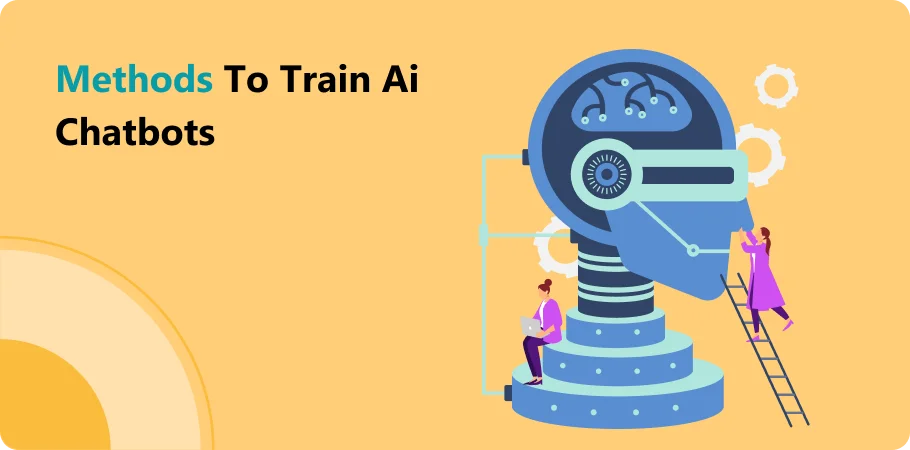
Continuous Learning
Facilitating continuous learning empowers AI bots to adapt to user preferences and improve responses through feedback integration, ensuring personalized and engaging interactions over time.
This iterative process not only facilitates the improvement of the training chatbots ability to generate human-like responses but also enables it to fine-tune its tone to ensure it aligns with consumers’ expectations, fostering a more natural and satisfying conversation.
Incorporating continuous learning mechanisms is instrumental in maintaining the train chatbot’s relevance and effectiveness in various contexts. By actively soliciting and incorporating consumers feedback, chatbots can adapt their responses to better resonate with consumers, ensuring that the is consistently maintained throughout interactions.
This iterative approach not only enables train chatbots to refine their understanding of consumers preferences but also empowers them to dynamically adjust their conversational style, ultimately culminating in more meaningful and personalized exchanges that right tone to customers’ needs and expectations.
Efficiently scaling train a chatbot involves optimizing processes through parallelizing computations and leveraging cloud infrastructure. Parallelizing computations allows developers to tap into distributed computing resources like GPU clusters or cloud services, expediting bot train and inference tasks. This approach not only accelerates model train but also ensures swift processing of inquiries from website visitors, enhancing customers experience.
Additionally, utilizing cloud infrastructure provides scalability and efficient resource management. Developers can dynamically allocate computing resources to handle fluctuations in traffic, crucial for scenarios where train talkbot interact with large volumes of website visitors.
Furthermore, integrating parallelization and cloud infrastructure optimizes the utilization of the knowledge base. This enhanced organization and accessibility of information enriches the train chatbot’s ability to provide accurate and proper responses to consumers queries, thereby create engagement with website visitors.
By harnessing parallel computations and cloud resources, train a chatbot can be streamlined for efficiency and scalability, ultimately improving performance and responsiveness in conversational interactions.
Multimodal Inputs
Create the AI chatbot’s capabilities through the integration of multimodal inputs expands its proficiency in understanding and responding to diverse forms of communication. Beyond textual inputs, talkbot are equipped to interpret images, videos, and voice recordings, enabling more immersive and interactive interactions with user inputs across different platforms.
This versatility enables train chatbots to accommodate users’ preferences, whether they prefer traditional text-based communication or more visually-oriented interactions, such as selecting options from a drop-down menu.
Moreover, the integration of multimodal inputs aligns with the evolving role of chatbots as virtual assistants, capable of assisting consumer in diverse tasks and contexts. By processing a wide range of input modalities, train a chatbot can provide more comprehensive support and guidance, enhancing their utility as virtual assistants across various domains and applications.
This comprehensive method of interaction not only boosts user engagement but also create the overall functionality and versatility of training an AI-powered virtual assistant chatbot training. By ensuring the incorporation of relevant information at every stage, developers can enhance the training process, enabling the assistant to adapt and respond effectively to diverse user queries. This emphasis on proper information fosters a more dynamic and responsive assistant, capable of addressing users’ needs across various contexts.
Furthermore, integrating proper information into the training regimen ensures that the assistant is equipped to handle a wide range of scenarios, thereby enhancing its utility and effectiveness. By prioritizing the inclusion of pertinent data, developers
create a robust foundation for the virtual assistant’s learning procedure, empowering it to provide accurate and valuable assistance to user. This holistic approach fosters continuous improvement and refinement, ultimately resulting in a more proficient and capable AI-powered assistant.
Privacy and Security
Ensuring privacy and security in train a chatbot necessitates the implementation of robust encryption methods and strict compliance with regulations. Developers must prioritize data privacy by integrating encryption mechanisms to safeguard sensitive & relevant information and comply with regulations like the General Data Protection Regulation (GDPR) and the California Consumer Privacy Act (CCPA).
By adhering to stringent privacy measures and regulatory requirements, developers create a secure environment that protects user data and maintains trust. Train implementing encryption not only safeguards sensitive information but also ensures compliance with regulations, mitigating risks associated with data breaches.
Moreover, prioritizing privacy considerations during chatbot training create an environment where user’s intent can trust that their data is securely managed account, enhancing their overall experience and fostering long-term engagement.
Case Studies and Best Practices

Exploring case studies and best practices offers insights into successful AI bot implementation strategies. Case studies highlight real-world applications of AI bot across various industries, showcasing innovative solutions and lessons learned from deployment experiences.
Additionally, best practices provide practical guidance for chatbot developers, covering topics such as data collection, model selection, and performance evaluation. By studying successful case studies and adopting best practices, chatbot developers can accelerate the development process and improve the effectiveness of their chat bot practicing & solutions.
Conclusion
In conclusion, mastering ai bot training requires a holistic approach that encompasses foundational knowledge, rigorous data collection, adoption of appropriate techniques, and continuous optimization.
Developers have different ways to create ai chatbots that deliver exceptional user intents experiences and foster meaningful interactions. Leveraging advanced machine learning algorithms is one approach, enabling chatbot training to continuously learn and adapt to user preferences. By incorporating diverse training data from various sources, developers can ensure that chatbot train are equipped to handle a wide range of inquiries and scenarios, enhancing their versatility and effectiveness.
Additionally, developers can explore different ways to optimize chatbot performance, such as fine-tuning algorithms and refining understand natural language processing models, to further enhance the quality of user experiences and drive meaningful interactions. Through these diverse approaches, developers can create ai chatbot training that not only meet but exceed user expectations, enriching the overall conversational experience.
As artificial intelligence technology continues to advance, the potential for artificial intelligence chatbot to revolutionize customer service, streamline operations, and enhance user engagement remains immense. By staying abreast of emerging trends and best practices in AI chatbot training, businesses can stay ahead of the curve and leverage the full potential of conversational AI bot training to achieve their objectives.
Get started for Free
Start for free today. Boost your sales by clicking the Get Started button. With CRMOne, you can manage leads, sales, and customer service all in one place.
